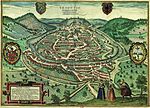Saint-Claude (Besançon)
Areas of Besançon
Saint-Claude is a large district of the east of Besançon.
Excerpt from the Wikipedia article Saint-Claude (Besançon) (License: CC BY-SA 3.0, Authors).Saint-Claude (Besançon)
Rue du Maréchal Lyautey, Besançon Saint-Claude
Geographical coordinates (GPS) Address Nearby Places Show on map
Geographical coordinates (GPS)
| Latitude | Longitude |
|---|---|
| N 47.256944444444 ° | E 6.0130555555556 ° |
Address
Rue du Maréchal Lyautey 3
25000 Besançon, Saint-Claude
Bourgogne-Franche-Comté, France
Open on Google Maps







